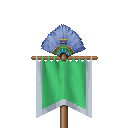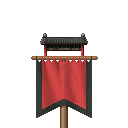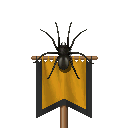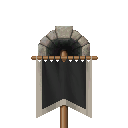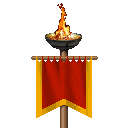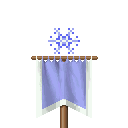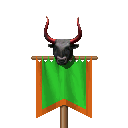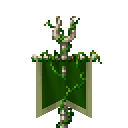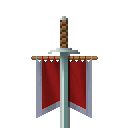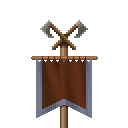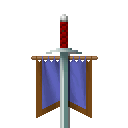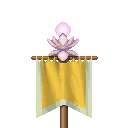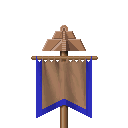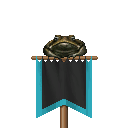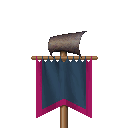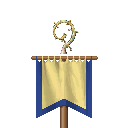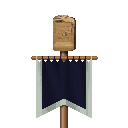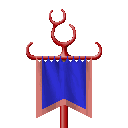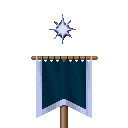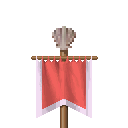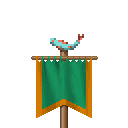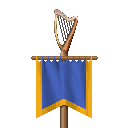This is an old revision of the document!
Nations of the Middle Ages
The Middle Ages (also known as the Middle Age, or MA) is the Second of Three eras that one can set their Ascension War in. Most of the living legends of the previous Ages have passed, but their footprints on the world can still be seen. Civilization has refined as a whole, with most of the chaotic, disorganized nations of the past either assuming some structure or giving way to better-built realms. There are a couple exceptions to this orderly trend, of course, but most of the Ages' thirty-five nations have adopted better equipment and more-formal positions for their denizens.
Click on the flags to get to the in-depth pages for each nation.
The Arcoscephale of the Middles Ages takes after the Kingdom of Macedon, which historically "inherited" Greek culture by conquering the city-states after the end of their Golden Era. While early Arcoscephale was playable at the height of its civilization, the Middle-Age Kingdom of Arcoscephale is already old and kinda crusty by the time you can play it; its Phalanx, Chariots, and War Elephants are all quite impressive, but you've missed the era when no one could match them by a century or two. On the other hand, practically no one else can drum up Healers quite like them, and their Astral Mages are remarkably cheap for their niche.







Ermor is DEAD! The glorious Human Empire of the Early Ages didn't decline very gracefully, especially with the dark secrets that it held. Push came to shove, and Death itself came knocking. The new God of Ermor is a Pretender of the Underworld, one who finds the self-destruction of the Empire hilarious and greatly enjoys raising its corpses to do their bidding. There are no national troops to pay for in Ermor, so you don't have to worry too much about Ermorian Dominion turning its taxpayers into ash – not that you can do anything about it, given the rate of decay. Forts and Temples are of utmost importance, however, as they denote ownership of the completely-wasted lands and provide valuable Death Gems.









Sceleria is one of the many Human factions spun from the old Ermorian Empire, and it comes first in the list for a very important reason. Seeing where Ermor's dark stuff was headed, the Heavens warned various Mage-Priest groups about it, and one such group encouraged a civil war to try and prevent fate from playing out. Needless to say, it was a self-fulfilling prophecy, and Sceleria is the winning faction of the civil war. Viewing Ermor as their cross to bear, the Mage-Priests have established a Death Cult that uses the same stuff that ruined their former Empire in a more-disciplined manner, hoping to hold the Undead off with more Undead. The living have stayed true to the Ermorian Legions, though without cavalry.
Centered on a distant Ermorian province of that once belonged to Sauromatian cannibals, Pythium is based on the Eastern Roman (or Byzantine) Empire. Like how the eastern half of the Roman Empire cut itself off from the west to avoid western problems, Pythium separated itself from Ermor when the Heavens told the local Mage-Priests what was going on in the imperial capital. These Mage-Priests, known as Theurgs, have continued to follow the Heavens and are now some of the most-skilled Human wizards in the world, bolstering their power in battle with the help of interns. The Pythian Legion has been less successful, though it now uses the native serpents as beasts of war.










Man is a feudal Kingdom loosely based on the medieval lore of England & Wales, with some fantasy novel stuff mixed in. It was once part of the Tuatha colonies of the Fir Bolg, but Human tribes that called themselves the Logrians gradually arrived with iron and slightly-better technology, expelling the Fir Bolg the minute the Tuatha disappeared. The Logrians were strong, but they couldn't unite under one King, ultimately getting vassalized by other Men whose Witches discovered a Tuatha Magic Site called Avalon. Man is a technological backwater compared to most other Human nations, but its people are hard at work learning new and interesting ways to use their tools and the Magic of the "elves".












While Man doesn't rip off too much national mythology, Eriu is quite apparently Irish. It's a bit of a play on the last bit of the Invasion Cycle of Irish Myths, where the Milesian Humans showed up and the Tuatha left for the underground. In this case, the Tuatha gave up on existing in this world after losing a single battle, retreating to the blessed isle that they started their empire on and making it disappear like a mirage. The Sidhe retreated to faery lands underground, and the Fir Bolg were abandoned to their fate. But now that the Sidhe have a god, some of the "elves" have returned to the now-Milesian lands – if only there were more "elves" to enlist.







Early-Age Ulm didn't win against Early-Age Ermor in the end, but the region survived its time under the Empire. It is now under an Iron Kingdom, based on that of the Germans. The people of Ulm are fully-confident in their physical prowess and mental acuity, regarding Magic and appeals to gods as low-brow cheating. Their greatest accomplishments are Blacksteel, a steel worked with Earth Magic (nobody tell them!), and the mighty Keep that their finest Human infantrymen tirelessly defend. Their Priests bless the steel of these Guardians instead of the Guardians themselves, making their halberds shake heretics to their core. Ulm could always use more Magic, though, especially since its men are quite weak to it.








Marignon is kind of a sister-Kingdom to Ulm, since both rose from the ashes of the same Empire. Marignon is far more zealous and far less minerally-gifted, however. It's kind of silly to imagine that their Spanish-or-French-themed soldiers in red shirts would've been considered "heavy infantry" in the Early Ages, especially since the Middle Ages have Blacksteel and crossbows. Marignon takes what it can get, however; you can't be picky with your recruits when the shadows of death are ever-present, after all. Being a heathen or a heretic outside Marignon is just as bad as being one within it, though, since religious fervor isn't only for the incompetent.







Middle-Age Mictlan is in the midst of what we can charitably call a "mid-life crisis", or possibly just an identity crisis. Having exhausted its supply of weaker subjects to sacrifice to the Hungry Gods of Old, in part due to Mictlan's technological stagnation, the Blood Cult has been usurped by a divine Serpent King. This King, named Quetzalcoatl but better-known as the Lawgiver, seeks to provide order and decency to the backwards Empire of the Rainforests. He didn't have any better technology to introduce, having ascended by virtue of his powerful Magic and his beefy serpentine strength, but his Air Magic and his peers will hopefully make up for the ban on Blood. His reforms have stabilized Mictlan's Dominion, at least.
Middle-Age T'ien Ch'i is a Celestial Empire, led by a family supposedly chosen by Heaven itself. In practice, nothing is expected of the Imperial family, and we aren't sure if the Emperor is even aware of the Ascension Wars. Those handling the affairs of the Empire are the Emperor's Eunuchs, who attend to all corners of the Empire and engineer all aspects of its society. Much of the nation's Early-Age character has been overwritten for the sake of stability, but professionals sponsored by the Emperor and the Eunuchs have filled most of the resulting holes with their own brands of Magic. Meanwhile, the army hasn't gotten much better.
Something strange happened to Machaka in between the Early Ages and the Middle Ages, and we don't know what. The clans are now meaningless and ignored, and the King is now a fall guy for the Priests. The true heads of the Kingdom are the Eyes, Ears, and Voices of the Machakan God, who serve as administrators, spies, and criers respectively. The only aspect of the nation not reserved for the Priesthood is its Magic, which is practiced by Witch Doctors. The strongest Witch Doctors in Machaka are secretly part-Spider, having either gained their power from the corpse of Machaka's previous God or inherited it from him directly. Spiders larger than horses are used as mounts by the bravest Machakan troops.








Agartha's attempted surface conquest in the Early Ages ended quite badly for them. The false god of the original Agarthans (also known as "Pale Ones") died shortly after their crusaders were destroyed, and then the Pantokrator's pantheon-binding Seal broke; it's likely that the Pale Ones broke it themselves as a last resort, but the few remaining Pale Ones wouldn't appreciate being blamed for the death of their own race. When Humanity counterattacked, they weren't stopped by the Pale Ones' might, but by the beauty of their perfectly-cut halls and statues. The remaining Pale One leaders, ironically now revered by the Human colonists, have thus begun to teach them the secrets of moving and shaping stone.
Abysia has seemingly entered a golden age of sorts. Its Warlocks have finally perfected their craft, wielding some of the strongest Blood Magic in the world, and continuingly using it to try and "perfect" their race. While their Demonbred creations have gotten better and more useful, their magnum opus of the Middle Ages is the Humanbred, a subspecies of Abysian with Human blood. The Humanbred Abysians live ten years longer than traditional Abysians and breed like fleshy creatures, giving the nation relatively-cheap and plentiful manpower. On the other hand, the Warlocks have still doomed their own race and are still unaware of that fact, just as the Abyssal architects of their traditions intended.











Middle-Age Caelum is broken, practically shattered. Its Priesthood's sacred goal was ruined by the Harab Seraphs, the representatives of the Raptor bros in the magocracy, when they crossed Fire & Death out of curiosity. The Seraphs of the Airya Clan (whose sisters were the Priestesses) wanted blood for this forbidden and ruinous act, leading to a civil war that scattered the Raptor bros and scared the remaining Yazatas away. Now the Airya Seraphs rule unopposed, barely tolerating the Spire Horn bros (who remained neutral) and bitterly opposed to everyone else. Caelum's Dominion has gotten colder, along with the nation's mood, but the Airya Seraphs and their Iceclad soldiers couldn't be happier about that.






When Ermor self-destructed, Death Magic became a sore subject in C'tis, and the Sauromancers couldn't help but feel a little responsible. Ermor stole their Death Magic after subjugating C'tis, after all. Knowing it was only a matter of time before their popularity would shoot through the floor, the Sauromancers that weren't busy performing damage control in Human realms rebranded; I'd have rebranded, too. Now known as the "Marshmasters", the wizards focused their attention and expertise on C'tis's swamp, stirring and awakening powers from before even the Early Ages in the process. Warm-blooded beings should try to avoid the new C'tissian Dominion, unless they're resistant to swamp-based diseases.
Civilization has started to come to Pangaea, although no one on earth will admit it. The bloody practices of old have been rejected, are are only performed by Panii of a dark mind and coat. The matriarchs of the "wild" faith have given way to less-powerful successors. Seeking to counter Human expansion, some of the Centaurs have even adopted "civilized" armor and practices; these Centaurs are considered to be untrustworthy hipsters by most Pangaeans, but their battle prowess has convinced some of the Minotaurs and Satyrs to imitate them. The changing of ways has convinced the Panii to act once more, either to crush the idea of civilization's superiority or to have one last hurrah.







Asphodel is a renegade faction of Pangaea, gripped with terror. In response to the expansion of Human civilizations, a dark god arose from the Vengeful Woods, convinced that civilization is the "death" of Nature and must be destroyed. The god's chosen disciples and Panii converts were struck with black fur, leading to their exile from Pangaea, thus allowing the god to teach them the powers to "reclaim" Nature. But what is dead cannot be truly restored; all that Nature can do is bind the dead thing's soul to its body and puppet it around with vines, and Nature under the dark god has started to do this to things that aren't even dead. These planty puppets don't pay taxes, but they still need money for fertilizer, annoyingly enough.








Vanheim's land, faith, magic, and government haven't changed, but virtually everything else about it has. An entire era of fighting the Frost Giants has prevented the Vanir from looking outward, while Humanity has settled in their lands. In previous Ages, the only Humans in Vanheim were thralls taken from other lands by Vanir raiders, but now they are born and raised here under their own chiefs. Admittedly expendable compared to the relatively-few Vanir, Humans now serve as Vanheim's infantry; even the elites are Men enchanted by the Vanir, while the average Van prefers fighting on horseback. Vanheim also reunited with Helheim at some point, and can now recruit Valkyries into their standing armies.







Jotunheim is the homeland of the Jotun, distant descendants of the glacial Frost Giants of Ages past. They were once dwarfed by the Niefel, more-direct descendants of the icy Titans; however, the Niefel had chosen not to stir their parents from their eternal slumber, in an effort to avoid being dwarfed themselves, and now all but one of the Niefel have fallen to time. Perhaps to avoid the blame for the extinction of their masters, the strongest Jotun Gygjas disappeared when the Niefel declined; however, the appearance of a new God they can schmooze has prompted them to return from exile. These powerful, varied Sorceresses are joined by tiny Goblins known as the Vaettir, and the sacred descendants of the last Niefel Jarl.






Vanarus takes after the Kievan Rus', a Slavic state formed by Scandinavian adventurers. Its tale began when Vanir adventurers founded the city of Novgård around the Pine of Skulls, a holy site to the Rusian Humans and Chudes. The war practically started itself; unfortunately for the Chudes, their Human allies were easily swayed by the "glamour" of the Vanir, while the Chudes themselves could only claim their excellence through being stronger than the Humans. The conflict ended right when Ulm tried (and failed) to conquer the place, with the Vanir as the pyrrhic victors. The Vanir rule their Kingdom, and nobody denies it, but their numbers are limited. The Humans have been quick to try and learn their new, darker magic.
At the end of the Early Ages, the Yakshas of Mount Kailasa decided it was time to go, while the Rakshasas of Lanka either did the same or were crushed sometime before then. That left the Bandar Log with no living gods to follow. Seeing no one above them to do the job, the Bandar apes codified the soft caste system of the Early Ages; the small, chittering Markatas were left at the bottom, the lanky Vanaras were to wear black and stay in the middle, and the Bandars were to wear red and do all the ruling. The white-furred Vanaras had been blessed with higher intelligence by the Yakshas, however, and were exempted from the caste system; they do what they want, while knowing that their next life will be awful if they sin.










Shinuyama (literally "Death Mountain" in Japanese) is a forested mountain realm that was once subject to the Oni of Yomi. At the end of the Early Ages, Yomi's gateways to the Netherworld mysteriously closed, and the seemingly-infinite power of the Oni Kings became quite-apparently finite. The Oni's Human & Goblin vassals revolted, and were victorious. Then the Goblins of Shinuyama – known as Bakemono – decided that it was their turn to loot the world for all it had, stealing the secrets of metallurgy from the Humans and styling themselves after the Oni. Bakemono range from pathetic to annoying, and hardly any of them understand Gods. What they understand is power, both physical and Magical.
Ashdod is a twin-city-state, ruling over the blood-salted lands that were once Hinnom. It is ruled by the Anakim, descendents of Anak, a Rephaite who was blessed when his Melqart father rejected the hedonistic practices of his kin. Most of the Giants in Ashdod's realm are Rephaim, but of far-lower power and hunger than their ancestors, while the Anakim are almost as strong as and far more disciplined than the "heroes" of old. Unfortunately, Ashdod has had trouble surviving on the strength of its men alone. Most revere their deceased first-generation ancestors, who now rule kingdoms in Sheol (Hell) and are still unrepentant of their ways; they can be summoned at great cost, along with Angels who pity them.
There is now more than one city in the land of Ur. One of these was chosen by the Entu (Priestess-Queen) of the Moon, EnHedu'anna, to be the site of her Great Temple of the Moon, and the First City's influence was lost as a result. With the loss of centralized spiritual power, the Priest-Kingdom fragmented into several different city-states, now collectively known as Uruk; luckily, they all follow the same Pretender, since EnHedu'anna herself foresaw its arrival. Uruk's faith in its Gods is as strong as it was in the Early Ages, so its Pretender never loses Magic paths when returning from the Underworld. However, no expense is spared on Uruk's Temples, so they now cost 800 gold apiece – at least they look nice.
Nazca is an Inca-themed splinter state of Caelians, cleft from Caelum during the civil war. Most of them are Raptor bros, to the point where they don't even use that name anymore, but the Kingdom also contains the family of the last Yazata to leave the earth. Isolation has done strange things to these Caelians; their technology has regressed, their language has changed completely (Yazatas are now called "Huacas", for example"), and dead officials are mummified to preserve their expertise. When a Yazata-descended Inca (King) and/or his Harab-Seraph-descended Coya wife dies, their spouse is mummified alongside them to create an Undead power couple.





What, you think Agartha had it bad? At least Agartha wasn't flooded by a catastrophic meteoric impact on the ocean floor. The flood cut the Zotz population down from millions to thousands, with most of the survivors being those who had invaded the rainforests of Mictlan as part of the Sun-seeking crusade. Then came the Atlantian Basalt Kings, who were forced in by the currents and sank the last Xibalban city with their powerful magic. Xibalba is now primarily populated by Atlantians, who have become more toad-like and now call themselves the Muuch. The Muuch are far less cost-effective than the Zotz, so the Muuch Kings actively subjugate every Zotz refuge they find (mostly forests & caves) and force them to serve.
Phlegra is the successor to Mekone, a Giant-led city-state that was famous for its terminal hubris. The Gigantes' God-Slayers ultimately failed, and the Gigantes that fought in or supported the war were cursed by a divine decree. They lost their reason and discipline, and their descendants lost their beauty. While stronger and somehow even more prideful than before, the Gigantes can't even understand their own legacy anymore, aside from whole slavery thing. They increasingly rely on the Elder Cyclopes to build everything for them, and have even begun to invite Human scholars known as the Trophimoi to decipher the Mekonean secrets for them; one from Pythium has made a breakthrough regarding Communions.






Phaeacia is the most successful part of Berytos, seeing how it hasn't been burned to the ground yet. A paradise in an otherwise-hellish archipelago, Phaeacia has attracted Berytians and their wealth ever since it was discovered; thus, when Arcoscephale's own navy came knocking, the Isle was able to pay them off with an exquisite tribute. Led by the half-Giant descendants of the last Bride-in-Waiting, the island has continued to gather wealth and prosperity, with the help of the self-sailing Black Ships that only appear in Phaeacian Dominion. People here live longer due to the Golden Apple Tree brought from one of the Hesperides, and they're protected by the Queendom's uncursed Gigante vassals.









Ind is a holy Kingdom of Kingdoms based on the late-medieval legend of Prester John. Apparently no one can find Ind because Ind's God wills that to be the case. In Magnificent Ind, every soldier is a priest (able to Bless themselves) and every noble is a king. Because of this, only the greatest priests in the land can truly be the Prophet of God him/herself. But the Magnificent center of Ind is small, and most of the people under Ind's control are horrible savages that must be reined in by the true-and-just Bishops. Ind also has vassals, ranging from Little Horned Men to the apparent stepbrothers of the Rephaim, but these are primarily concerned with their own affairs (such as driving off vicious birds) and will only actively serve the Prester King when provided with a Fort.
Na'Ba is based on Petra, the capital city of the Nabateans, with lots of other Arabian lore mixed in for added flavor. It's led by the Jann, the descendants of 'Adite Half-Giants from (what was once) Hinnom and Jinnun from (what was once) Ubar. Though the Jinnun are all sleeping (since they used up most of their Magic in the Early Ages), the 'Adites still serve as the stonecutters for the Queendom. The Queendom's cities are carved from the cliffs of the same plateau that Ubar was hidden in, and many trinkets enchanted or even inhabited by the Jinnun can still be found in the surrounding deserts; they've been a major export even before Na'Ba was formed, which is probably why the nation has such a large population of Humans.
The Atlantis of the Early Ages was destroyed by a catastrophic meteoric impact. The Dark Crystal was shattered, and the Earth itself broke beneath the Basalt City, dooming most of its inhabitants to hellish fates. But the Atlantians are an adaptive race, and this was not the end for them. The lower-tier Mages took the initiative, mastering the coral-crafting arts and erecting a new Kingdom for the Atlantians of the shallower waters. While unrivaled at Water Magic, these Mages realized that Atlantians were slow learners, so they also mastered the art of Water Breathing and taught it to a few promising Humans. Now Atlantis can count on finding a Mystery Cult of the Deep in every coastal city, providing cheap Mages & zealots.









The R'lyeh of the Early Ages was practically vaporized by a catastrophic meteoric impact on the ocean floor (the same one that destroyed Atlantis and Xibalba). Ironically, said meteor was a piece of another world, containing the remnants of another R'lyeh from just outside the Stellar Sphere. This R'lyeh is run by Illithids, squiddy Magic Beings who drain life with a touch and overpower minds at a whim. Like their Terrestrial predecessors, the Illithids rely on hordes brainwashed slaves as they attempt to take root, performing heinous experiments with Humans and underwater races in an attempt to subvert their competition. These guys also have a connection to almost-indescribable beings from beyond the stars, however.
Despite being thoroughly-acquainted with its Early-Age rivals and losing its allies on-land, Pelagia has survived to the Middle Ages. Survival didn't come without changes, however; its Giant Triton Kings relinquished their spiritual authority, its tribal distinctions dissolved (save for the Pearl & Coral Clan nobles, & the Amber Clans that joined after being thoroughly-stomped by the Atlantians), and it traded out its ocean-derived equipment for works of bronze from the surface. Pelagia even allows Mermen to dream of owning stakes in the Closed Realm (the surface), though the Kingdom still distrusts Mermen and only nurtures them because dry land is far too valuable to ignore. Fire has become a major Mermen "heresy".






Neither Oceania nor Pelagia were directly impacted by that catastrophic meteoric impact on the ocean floor, and this was a godsend for Oceania. The halfmen of the seas had been unable to hold back the Atlantians of the Basalt City, who were an invasive species that not even the kelp forests could bear. Heck, even modernizing a bit by adopting bronze gear and building Fortresses of stone wasn't enough. With the "Falling of the Star", however, the Atlantians were stopped in their tracks. Then the halfmen caught glimpses of the "Starspawn" enslaving the Atlantians, and realized that now was their chance to push back. Oceania's Mages are unchanged from the Early Ages, by the way, so go wild!





Ys is a Breton-themed nation tied in with the story of the Tuatha. It's centered around Ker-Ys, an opulent city founded by a Tuatha named Malgven, after Malgven married a Human vassal chieftain named Grandlon (a legendary King of the Bretons). When Malgven left Ker-Ys to resume her campaigns in the north, she found that the Tuatha's era had passed, while her spouse died of old age and their daughter Dahut was greeted by fleeing Tuatha Sorceresses. At the behest of the Sorceresses, Dahut hid Ker-Ys beneath the waves, where she and the Sorceresses transformed into Morgens. These "elves" are only found in Ker-Ys, but Ys has green Merfolk to call upon under the sea, while Grandlon's tribe lingers on the shore.










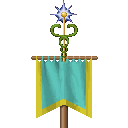
 1
1
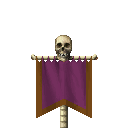

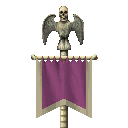









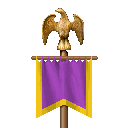
 1
1 5
5

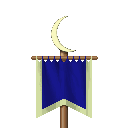

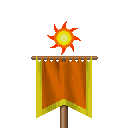
 1
1